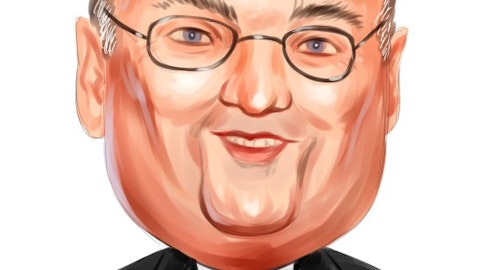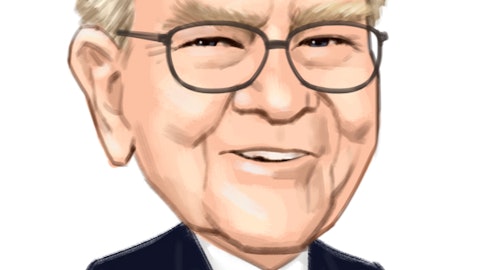T-Mobile US, Inc. (NASDAQ:TMUS) Q3 2023 Earnings Call Transcript October 25, 2023
Operator: Good morning. [Operator Instructions] I would now like to turn the conference over to Mr. Jud Henry, Senior Vice President and Head of Investor Relations for T-Mobile US. Please go ahead.
Jud Henry: All right. Welcome to T-Mobile’s third quarter 2023 earnings call. Joining me on the call today are Mike Sievert, our President and CEO; Peter Osvaldik, our CFO, as well as other members of the senior leadership team. During this call, we will make forward-looking statements which involve a number of risks and uncertainties that may cause actual results to differ materially from our forward-looking statements. We provide a comprehensive list of risk factors in our SEC filings, which I encourage you to review. Our earnings release, investor fact book, and other documents related to our results, as well as reconciliations between GAAP and non-GAAP results discussed on this call can be found in the quarterly results section of the investor relations website. With that said, let me kick it over to Mike.
Mike Sievert: Okay. Thanks, Jud. Good morning, everybody. If you’re watching on our webcast, you can see we’re coming to you from New York City and, here with several members of my senior leadership team, and we’re looking forward to discussing another quarter of great results. Our strategy to deliver the best network coupled with the best value and the best customer experience has remained remarkably consistent. And our Q3 results again show how well that strategy is working with another quarter of industry leading customer and financial growth. I want to thank our amazing team nationwide. We have tackled a lot of change together recently to position our company for success in the future, and it hasn’t all been easy. But this team showed once again what loving customers looks like and how that simple philosophy translates into success.

Aerial view of high-rise buildings with a telecom tower in the background emphasizing the importance of communications infrastructure. Editorial photo for a financial news article. 8k. –ar 16:9
I’m sure you’ve seen the numbers already. So I’m going to spare you the greatest hits album of all the quarterly results and just a couple of things with a few comments so that we can get [Technical Difficulty] First, as we announced yesterday, I am so proud of our network team for reaching our audacious goal of 300 million people covered with dedicated mid-band 5G over two months ahead of our year-end target. We announced this goal nearly three years ago. And then we got to work and got it done. And to this day, no one else in our industry has stated any plans to match it at any time in the future. I know it may get confusing with others celebrating their C-band deployments, which might have a casual observer. Believe, our network lead could be narrowing, but the opposite is true.
In fact, even after their C-band deployments, according to Ookla, T-Mobile’s nationwide median speeds were double the next competitor’s speeds in September — double in September. And our mid-band 5G square mile coverage is also double the next closest competitor, meaning, others still have a lot of wood to chop beyond just population dense pockets to ever reach the expansive geography where T-Mobile is today. And we have more spectrum dedicated to 5G than anyone else. Before we’ve even begun to deploy our C-band, our 3.45 GHz spectrum, or Auction 108 2.5 GHz licenses, let alone re-farming our AWS. Listen, we started the 5G era two years ahead of the competition and today we remain two or more years ahead. And I predict that two years from now, we still will be.
What all this translates to is a superior customer experience. We’re rapidly putting our spectrum resources to work for the benefit of consumers and businesses. And we’re doing it with the best capital efficiency in the industry. Most exciting part, many prospective customers are only just beginning to take notice that T-Mobile is the overall network lever, leaving lots of growth runway ahead. And we’re also expanding on our long-held fame for delivering the best value. Our latest Un-Carrier move is freeing customers locked into three-year contracts, and our new Go 5G rate plans are delivering the most feature-rich options in wireless. Phone freedom has turned out to be one of our most exciting Un-Carrier moves ever, and it continues to bring high-quality switchers to T-Mobile, as you could see in our industry-leading postpaid account growth.
We’re also executing on our ARPA revenue growth strategy, posting another strong quarter well over plus 1% versus a year ago and revenue per account on the strength of Go 5G plus and multiple products. Some have asked, if our new higher value rate plans are most popular with consumers, then why isn’t ARPU growing faster too? And I’ll point out that consumer ARPU does continue to grow even after offsets from growing segments like 55+ and military. And consumer overall is being partially offset by profitable growth in the enterprise space at somewhat lower ARPUs, but attractive CLVs, a development that’s contributing well to our financial growth. And we’re doing all of this within a backdrop of a wireless industry that continues to grow service revenues and cash flows, while simultaneously seeing customers win from healthy competition that delivers more value and better networks.
In fact, this industry produces cash flow and EBITDA much higher than five years ago, while at the same time, customers are enjoying 3 times more data at 4 times higher speeds, while paying just a fraction of the price per unit consumed versus before. And that’s before factoring in the expanded device promotions now routinely offered. A vibrant profitable business delivering rapidly improving network service and value. That’s the win-win 5G dividend nobody’s talking about, and it helps to showcase why T-Mobile’s 5G leadership is so important. This is certainly true in T-Mobile for Business, where we have the highest ever account net ads overall and our highest ever postpaid nets in enterprise based on the strength of our 5G enabled solutions.
Consumers are also choosing T-Mobile above all others. Prime network seekers in the top 100 markets increasingly recognize that T-Mobile offers the best combination of network coverage and capacity to meet their needs. And for the first time ever, T-Mobile also won the highest share of switchers in smaller markets and rural areas in Q3. Broadband also had another strong quarter. We now serve over 4.2 million customers who are enjoying a great experience with net promoter scores that remain more than 30 points higher than cable, with churn improving year-over-year as well. We remain very much on pace for our longer term goals with 5G broadband. Overall, our customer growth strategy remains differentiated and durable, resulting in industry leading service revenue growth both at the total company level and at the postpaid service revenue level where most of the value is created, which grew more than 6% or more than 1.5 times the growth rate of peers.
That top-line leadership coupled with our synergy realization and focus on cost efficiencies drove double-digit growth and core adjusted EBITDA with the highest free cash flow conversion in the industry. This allows us to not only raise our guidance for this year again, it also gives us excitement and confidence in the future. With our significant growth opportunities continuing to scale, with lots of room to run, it sets us up for sustained leadership in both customer and service revenue growth as we look ahead. And we see opportunities amid the rapidly changing technology landscape as well, all across our business, to drive further revenue growth, margin expansion, and free cash flow growth that will allow us to fund our growth investments in our customers and network, as well as provide the potential for substantial ongoing shareholder returns.
This amazing customer-loving team continues to perform beautifully with so much exciting potential ahead, showing why it’s not just a tagline when we say that for customers, employees, and investors alike, it’s better over here at T-Mobile. Okay, Peter, over to you to talk about our key financial highlights and an update on our guidance.
Peter Osvaldik: All right. Thanks, Mike. Our ongoing delivery of best-in-class customer and financial growth quarter after quarter enables us to increase our guidance once again. So let’s jump into the details. We now expect total postpaid net customer additions to be between 5.7 million and 5.9 million, up 50,000 at the midpoint. This reflects continued progress across all our core growth initiatives, partially offset by the deactivation of lower ARPU postpaid other data devices in the education sector, the largest of which arose during Q3. As you know, our ability to uniquely solve customer pain points led to significant connection growth in the educational sector during the pandemic, supporting the rapid need for remote learning solutions.
As things are increasingly returning to normal, we had anticipated many of these connections to roll off in 2023 and do not expect the deactivation of these educational connections to have any material impact to service revenue looking forward. Included in the 5.7 million to 5.9 million is our expectation of approximately 3 million postpaid phone net additions for the full year. Our focus on profitable growth allows us to fund those higher postpaid phone net ads and still increase our core adjusted EBITDA expectation, which we now expect to be between $29 billion and $29.2 billion. This is up over 10% year-over-year at the midpoint, fueled by higher service revenues and synergies, and excludes leasing revenues of approximately $300 million as we transition substantially all remaining customers off device leasing by year end.
Our merger synergies are expected to be approximately $7.5 billion in 2023, achieving the full run rate synergy target provided at our Analyst Day a year ahead of schedule as we build towards the full run rate synergies of $8 billion in 2024. Now with the merger integration now substantially behind us, we will discontinue reporting synergies separately from overall business results going forward. We continue to expect merger-related costs, which are not included in adjusted or core adjusted EBITDA, to be approximately $1 billion before taxes. And we now expect cash merger related costs of $1.7 billion to $1.9 billion for 2023 as they have under run the P&L recognition to date. Net cash provided by operating activities which include payments for merger related costs are now expected to be in the range of $18.3 billion to $18.5 billion.
We now expect cash CapEx to be between $9.6 billion and $9.8 billion, delivering our network milestones ahead of schedule at a capital efficiency unmatched in our industry. The higher operating cash flows not only fund the increased CapEx, but also allow for a slight increase to free cash flow, now expected to be between $13.4 billion to $13.6 billion, which includes payments for merger-related costs. Not only is this up approximately 75% over last year, thanks to our margin expansion and capital efficiency, but also represents a free cash flow to service revenue margin, which is multiple percentage points higher than peers with further expansion expected next year. Consistent with the entire year, the updated free cash flow guidance does not assume any material net cash inflows from securitization.
Turning to income taxes, we continue to expect our full year effective tax rate to be between 24% and 26%. And finally, we continue to expect full year postpaid ARPA to increase slightly more than 1% as we continue to expand our account relationships as part of our land and expand account strategy to grow service revenue. In closing, our differentiated and profitable growth strategy continues to deliver industry-leading growth and service revenue, core adjusted EBITDA, and free cash flow along with the highest free cash flow conversion in the industry to unlock shareholder value. And with that, I’ll now turn the call back to Jud to begin the Q&A.
Jud Henry: All right, let’s get to your questions. You can ask a question via phone by pressing one followed by four or via XTwitter by sending a tweet to @T-MobileIR or at Mike Sievert using #TMUS. We’ll start with a question on the phone. Operator, first question please.
See also 12 Cheap Biotech Stocks Smart Investors Are Piling Into and 13 Best Solar Energy Stocks To Invest In Heading Into 2024.
Q&A Session
Follow T Mobile Usa (NYSE:TMUS)
Follow T Mobile Usa (NYSE:TMUS)
Operator: Thank you. Our first question is from the line of John Hodulik with UBS. Please go ahead.
John Hodulik: Great. Thanks. Two question if I can. First of all, the comments on the rapid share gains in the rural markets were sort of new this quarter. Mike, anything you could tell us about sort of where you are and sort of how much room you have to go to penetrate these markets. And then secondly, maybe for Peter, there was a comment in the 10-Q about the workforce reduction and the fact that it would drive OpEx down on a year-over-year basis in 2024. I guess two parts there. One, are there any way you could quantify the OpEx reduction and are there other factors involved that are potentially allowing you to see that OpEx reduction on a year-over-year basis? Thanks.
Mike Sievert: Okay, John. Let’s start with Jon Freier who maybe can give a little color on what we’re seeing in smaller markets and rural areas. As you heard in my prepared remarks, this is a huge milestone, because T-Mobile achieved leadership in share of switchers for the first time ever across the entirety of what we call smaller markets and rural areas, which is about 40% of the country.
Jon Freier: Yes, you bet, Mike. So yes, just to pick it up on that, 40% of the country, everything outside of the top 100 markets is how we define smaller markets and rural areas. It’s about 140 million people, 50 million households, and again, 40% of the market. And we just could not be more delighted. I’ve been talking to you about this for a couple of years now relative to our ambitions in smaller markets and rural areas and bringing real 5G. When you think about a lot of the places that we’re playing, we’re bringing the only 5G network into town. And given the announcement that we just made a couple of days ago around 5G Ultra Capacity now bringing that to 300 million people across the entire country. So it’s a huge opportunity when we bring the network, we’re bringing the distribution, we’re bringing our marketing and our special sauce relative to our value proposition and more choice to smaller markets and rural areas.
It’s been fantastic. It’s a huge milestone for us to be across all these markets now the leader of share of port ends. We’re not playing in all the markets, just as a reminder. It’s about 70% of the markets that we’re playing in. We’re not even playing across all the markets. And even with that, now we’re the share leader in terms of share taker, I should say, not necessarily share leader, but share taker. And I mentioned this a few times. We’ve had a dedicated team as a big part of our success in smaller markets, rural areas, really getting at to this with our dedicated team that’s focused on driving the kind of commercial success that we’re looking for. And our overall ambition is unchanged. And we’re right on track to hit 20% share of household by the end of 2025.
Mike Sievert: You take these last couple of quarters and drag them right, we’ll be the share leader soon enough in smaller markets and rural areas. Peter, any comments on OpEx for 2024? Why don’t you just go ahead and roll out the guidance for 2020?
Peter Osvaldik: Yes, exactly. [Multiple Speakers] Yes, so I got up too early to roll out 2024 guidance, that’s for sure. But in your question of workforce transformation. Look, I think Mike touched upon it at the beginning, and you saw us comment around this before. This is really about a tough set of actions, but as we got through the balance of the integration, we had to make some changes. That’s what this team does. It looks around corners and it says, we need to make sure we create clarity in the operating of this organization, bring that entrepreneurial spirit back and make sure that we’re looking at what are the headwinds and what are the tailwinds. As we think about what we laid out at Analyst Day, which seems like so long ago with respect to 2024 and what we were going to do there.
A lot in the world has changed, but it’s a set of all of these tailwinds and actions that we’ve created that still gives us confidence that we think, certainly from a core EBITDA perspective, again, I’m not going to roll out all the 2024 guidance, but we’re going to come right in there in the middle of the range. And these are the kind of actions that are necessary to create that opportunity and keep bringing the ability to invest in customers and the network and the business as we are.
Mike Sievert: I was kind of kidding, but you did roll out the guidance. Okay. That’s pretty good. It is remarkable that we did this Analyst Day years ago, I think, early in 2021 and laid out several years of expectations. And as we sit here today, knocking on 2024, we’re able to outlook a year next year that looks just like we had anticipated, right down the middle. And that’s something that I’m particularly proud of, given that it’s not at all like we thought. I mean, it’s really different than we thought. And yet we make course corrections as we go to keep the promises that we made to you front and center, a vibrant growing business, developing EBITDA and cashflow, and doing breakthrough things for customers and businesses. And that’s what’s happening. So we couldn’t be more excited about next year. Operator, next question.
Operator: Our next question is from the line of Simon Flannery with Morgan Stanley. Please go ahead.
Simon Flannery: Great. Thank you very much. Good morning. Mike, you talked about some of the additional growth opportunities and perhaps you just revisit the fiber [pilot program] (ph) and how that’s going, how you’re thinking about that? There’s been a lot of speculation about different assets. I think you’ve talked in the past about asset light. And then related to that, fixed wireless expansion and analyzing millimeter wave, overlay solutions and other ways to add capacity, any updates on that. It sounds like you’ve still got C-band and 3.45 to bring to bear on that. But any color there would be great.
Mike Sievert: Yes. Thanks, Simon. Well, nothing’s changed in terms of our philosophy and approach as it relates to broadband. And just to take you back, what we had said still holds, which is, we are conducting all kinds of experiments in the space, including observing our national performance in 5G home broadband, which, if anything, that performance and the resonance of our brand and our team’s ability to execute in the space, along with the trials that we’re doing in fiber, only bolster our confidence that our brand and our team belong in this market. But nothing has changed in terms of our philosophy. We like this business model, and to the extent we make investments or partnerships in the area, our view is, it should be capital light, generally off balance sheet, et cetera.
Speculation, I know is out there. I can’t clarify we’re not the partner to [JANA] (ph) in the transaction that was rumored a couple weeks ago. Although we remain interested in partnerships like the kinds we have rolled out pilots around and other constructs that are generally capital light, generally off balance sheet. And that’s for a reason. We’re performing really well and demonstrating through our tests as well as our broad scale performance in 5G home broadband that our brand and our team belong in this space and we can create value. As it relates to new ways to do wireless broadband, you said it at the very end there, and I mentioned in my remarks, Ulf and team, now that they’ve reached 300 million people with mid-band Ultra Capacity 5G are now setting about the task of deploying all of our spectrum resources to that base.
And we’re only just beginning. We have the bulk of our 2.5 GHz now rolling out. But our target is to be at 200 megahertz around the end of this year deployed against the 300 million people. And then more room to run next year, because as I said, we have Auction 108 proceeds still pending, we have C-band that we haven’t deployed, 3.45, as well as refarming potential from spectrum being used for LTE right now, like AWS. And so lots of room to run as it relates to pouring new capacity into this network. And that means, we right now at a broad scale are not looking at alternatives to that from a wireless standpoint. We use millimeter wave pretty strategically in very dense places and so far that’s a great use for it. I will say, as we said last time, so no change, that we remain open minded to whether there are techniques that would allow us to deploy capital specifically for 5G broadband and make a great return for you.





